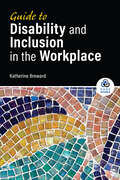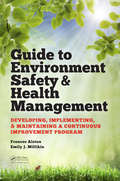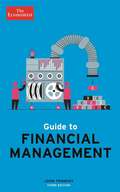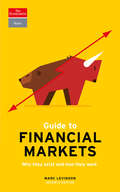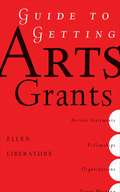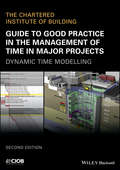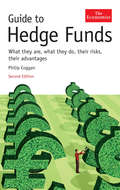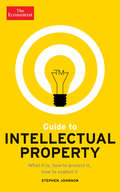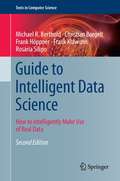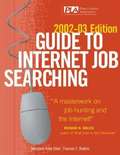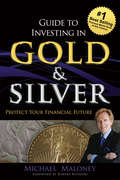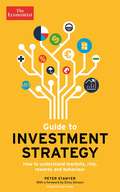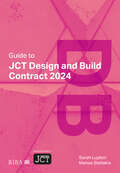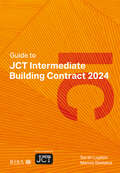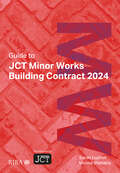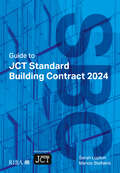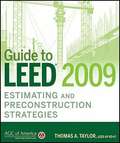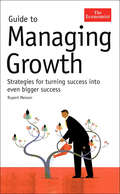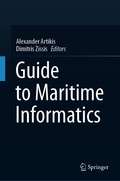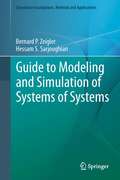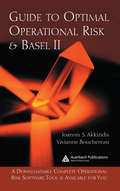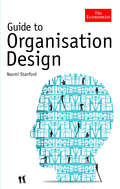- Table View
- List View
Guide to Disability and Inclusion in the Workplace (SAGE Works)
by Katherine BrewardMaster the ethical and practical aspects of disability accommodation. Learn effective strategies, overcome common barriers, and build a thriving workplace for all. Real-world examples and best practices. Engage with practical scenarios and exercises. Go beyond compliance and build a culture of inclusion. Empower your workplace, unlock potential, and create a competitive edge.
Guide to Disability and Inclusion in the Workplace (SAGE Works)
by Katherine BrewardMaster the ethical and practical aspects of disability accommodation. Learn effective strategies, overcome common barriers, and build a thriving workplace for all. Real-world examples and best practices. Engage with practical scenarios and exercises. Go beyond compliance and build a culture of inclusion. Empower your workplace, unlock potential, and create a competitive edge.
Guide to Economic Indicators
by Norman FrumkinNow revised and expanded, this widely-used desk reference provides quick and easy access to current and reliable data on the major statistical measures of the U.S. economy. Equally useful for students, general readers, economists, analysts, journalists, and investors, the guide provides concise, jargon-free explanations of the meaning, use, and availability of more than 70 macroeconomic indicators, including websites, recent trends, and current data.
Guide to Environment Safety and Health Management: Developing, Implementing, and Maintaining a Continuous Improvement Program (Systems Innovation Book Series)
by Frances Alston Emily J. MillikinDevelopment and execution of a successful ES&H program in today's profit-driven business climate is challenging and complex. The techniques outlined in this book provide guidance and aid in understanding the challenges that must be addressed by ES&H management and professionals. This book covers the primary areas of ES&H and key elements that should be considered in developing, managing, and implementing an effective, compliant and cost effective program. It to fulfills the need that exists in the workplace for guidance from a practical experience view point.
Guide to Financial Management: Understand and Improve the Bottom Line (Economist Books)
by The Economist John TennentA practical and accessible overview of the fundamentals of business finance--now in its third edition.Managers are constantly expected to make decisions that reflect a full understanding of the financial consequences. In the absence of formal training, few people are prepared for the responsibilities of dealing with management reports, budgets, and capital proposals, and find themselves embarrassed by their lack of understanding.This book is a practical guide to understanding and managing financial responsibilities. Each chapter examines actual tasks managers have to do, from "how to assemble a budget," "how to read variances on a report," to "how to construct a proposal to invest in new equipment," exploring the principles that can be applied to each task, illustrating practical ways these principles are used, and providing guidance for implementation.Guide to Financial Management will help readers understand financial jargon, financial statements, management accounts, performance measures, budgeting, costing, pricing, decision-making, and investment appraisal. This third edition has been fully revised and expanded with detailed examples from 100 leading businesses around the world.
Guide to Financial Markets: Why they exist and how they work (Economist Books)
by Marc LevinsonThe revised and updated 7th edition of this highly regarded book brings the reader right up to speed with the latest financial market developments, and provides a clear and incisive guide to a complex world that even those who work in it often find hard to understand.In chapters on the markets that deal with money, foreign exchange, equities, bonds, commodities, financial futures, options and other derivatives, the book examines why these markets exist, how they work, and who trades in them, and gives a run-down of the factors that affect prices and rates.Business history is littered with disasters that occurred because people involved their firms with financial instruments they didn't properly understand. If they had had this book they might have avoided their mistakes. For anyone wishing to understand financial markets, there is no better guide.
Guide to Getting Arts Grants
by Ellen LiberatoriGet that arts grant and be more independent! In this book, artists and arts groups will find all they need to know to support themselves through grants and special projects. This expert guide, written by an insider who has been on both the grant-making and the grant-writing side of the arts, shows readers how to assess their personal strengths and set goals to pursue their dreams. Hands-on examples and how-to exercises are provided for every situation: from creating artists' statements, to writing letters, fellowship applications, and arts-organization applications, to being ready for that all-important site visit. Online resources, tips on portfolio and personal prep, and information about the inner workings of boards and how to handle the yes, the no, and the maybe make this the complete guide to getting that arts grant. More than 66,000 foundations give grants-this book helps artists get them Unique exercises from an insider, plus upbeat, positive approach Focuses on personal preparation for applying for and getting a grant
Guide to Good Practice in the Management of Time in Major Projects: Dynamic Time Modelling
by CIOBA practical treatise on the processes and standards required for the effective time management of major construction projects This book uses logical step-by-step procedures and examples from inception and risk appraisal—through design and construction to testing and commissioning—to show how an effective and dynamic time model can be used to manage the risk of delay in the completion of construction projects. Integrating with the CIOB major projects contract, the new edition places increased emphasis on the dynamic time model as the way to manage time and cost in major projects, as opposed to the use of a static target baseline program. It includes a new chapter distinguishing the principal features of the dynamic time model and its development throughout the life of a project from inception to completion. Guide to Good Practice in the Management of Time in Major Projects—Dynamic Time Modelling, 2nd Edition features new appendices covering matters such as complexity in construction and engineering projects, productivity guides (including specific references to the UK, Australia, and the USA), and a number of case studies dealing with strategic time management and high-density, resource-based scheduling. Provides guidance for the strategic management of time in construction and civil engineering projects Demonstrates how to use a dynamic time model to manage time pro-actively in building and civil engineering projects Sets out processes and standards to be achieved ensuring systematic documentation and quality control of time management Integrates with the CIOB major projects contract Guide to Good Practice in the Management of Time in Major Projects—Dynamic Time Modelling, 2nd Edition is an ideal handbook for project and program management professionals working on civil engineering and construction projects, including those from contractors, clients, and project management consultants.
Guide to Hedge Funds: What They Are, What They Do, Their Risks, Their Advantages (Economist Books)
by Philip CogganIn 1990 hedge funds managed some $39 billion of assets and were almost unknown. By 2008 that figure had grown to almost $2 trillion and hedge funds were being blamed by some for contributing to the credit crunch and demonised by others for their greed. The rise of the industry has created a new bunch of billionaires, who have made themselves rich by managing other people's money. Nowadays most people have heard the term 'hedge fund' but few are clear about what exactly a hedge fund is or what it does. This guide aims to put them in the picture with the clarity and lively prose that The Economist is famous for. It provides a succinct survey of the industry for all those who think they should know about hedge funds, but do not. It is aimed at all those who might want or have to deal with a hedge fund: private investors, trustees of a pension fund, directors of a listed company, lawyers and accountants who may be interested in working in the industry. It is also aimed at those who happily criticise hedge funds without really knowing what they do.
Guide to Intellectual Property: What it is, How to Protect it, How to Exploit it (Economist Books)
by Stephen JohnsonIntellectual Property (IP) is often a company’s single most valuable asset. And yet IP is hard to value, widely misunderstood and frequently under-exploited. IP accounts for an estimated $5trn of GDP in the US alone. It covers patents, trademarks, domain names, copyrights, designs and trade secrets. Unsurprisingly, companies zealously guard their own ideas and challenge the IP of others. Damages arising from infringements have fostered a sizeable claims industry. But IP law is complex, and the business, financial and legal issues around it are difficult to navigate. Court decisions and interpretation of IP laws can be unpredictable, and can dramatically change the fortunes of businesses that rely on their IP - as demonstrated in the pharmaceutical industry’s battle with generic drugs. This comprehensive guide to intellectual property will help companies, investors, and creative thinkers understand the scope and nature of IP issues, pose the right questions to their advisers and maximize the value from this crucial intangible asset.
Guide to Intelligent Data Science: How to Intelligently Make Use of Real Data (Texts in Computer Science)
by Frank Klawonn Christian Borgelt Frank Höppner Michael R. Berthold Rosaria SilipoMaking use of data is not anymore a niche project but central to almost every project. With access to massive compute resources and vast amounts of data, it seems at least in principle possible to solve any problem. However, successful data science projects result from the intelligent application of: human intuition in combination with computational power; sound background knowledge with computer-aided modelling; and critical reflection of the obtained insights and results.Substantially updating the previous edition, then entitled Guide to Intelligent Data Analysis, this core textbook continues to provide a hands-on instructional approach to many data science techniques, and explains how these are used to solve real world problems. The work balances the practical aspects of applying and using data science techniques with the theoretical and algorithmic underpinnings from mathematics and statistics. Major updates on techniques and subject coverage (including deep learning) are included.Topics and features: guides the reader through the process of data science, following the interdependent steps of project understanding, data understanding, data blending and transformation, modeling, as well as deployment and monitoring; includes numerous examples using the open source KNIME Analytics Platform, together with an introductory appendix; provides a review of the basics of classical statistics that support and justify many data analysis methods, and a glossary of statistical terms; integrates illustrations and case-study-style examples to support pedagogical exposition; supplies further tools and information at an associated website.This practical and systematic textbook/reference is a “need-to-have” tool for graduate and advanced undergraduate students and essential reading for all professionals who face data science problems. Moreover, it is a “need to use, need to keep” resource following one's exploration of the subject.
Guide to Internet Job Searching: 2002-03 Edition
by Frances E. Roehm Margaret Riley DikelCopublished by America's foremost career books publisher and the Public Library Association, the acclaimed Guide to Internet Job Searching helps you harness the power of the Internet to aid in your job search. The Internet has revolutionized the way people look for career opportunities, and with this guide, you, too, can efficiently and successfully explore the Web to find the right job for you. This bestselling guide shows you how to target the most interesting jobs in the most promising companies and apply for those jobs with confidence-online or on paper. And it will steer you away from electronic "dead ends" such as unproductive searches that turn up thousands of near misses. Whether you are a complete beginner or an online expert, you'll find invaluable advice inside to make your Internet job search streamlined, efficient, and effective-from logging on to landing the perfect job. Margaret Riley Dikel, author of The Riley Guide (rileyguide.com), is a private consultant specializing in the use of the Internet for employment and career information. She is an internationally recognized authority in this field, having worked for many prominent governmental agencies and public and private corporations. Frances E, Roehm is the SkokieNet librarian at the Skokie (Illinois) Public Library where she specializes in building the village's community online. She is also the webmaster for ChicagoJobs.org, a regional resource for Chicagoland job hunters and career changers, and assists individuals in using the Internet to find a job. She currently chairs the PLA Job and Career Information Services committee.
Guide to Investing in Gold & Silver
by Michael Maloney Foreword by Robert KiyosakiYou hold in your hands an updated version of the book that accurately predicted the global stock market crash of 2008, the bursting of the real estate bubble, and Ben Bernanke's unprecedented overreaction via 'Quantitative Easing' programs. First published in 2008, the book quickly became a best seller not just for its timely insight into precious metals investment - but for its amazingly accurate prediction of a 'Roller Coaster Crash'- the manipulated whipsaw between inflation, deflation and back again. In this latest update to his book, author Michael Maloney adds his thoughts on what has played out so far, what we may be facing soon, and how gold and silver can help you transform the coming economic storm into a once in a lifetime opportunity. Gold & Silver have served as the ultimate safe-haven from financial chaos throughout history, and today is no exception. All the underlying fundamentals that caused the financial meltdown of 2008 have not been solved, but have been magnified by the actions of the world's central banks. The, bailouts currency creation, market manipulation, derivatives expansion, and growth of the "too big to fail" banks only guarantee that the next crisis will make the crash of 2008 look like a speed-bump on the way to the main event. Never in history has the global economy stood at such a precipice, and never in history has it been more vital to understand how, why and where to invest in gold and silver. Book jacket.
Guide to Investment Strategy: How to understand markets, risk, rewards and behaviour (Economist Books)
by The Economist Peter Stanyer Stephen SatchellNow in its fourth edition, this classic guide to investment strategy has been revised to give up-to-date ideas on pensions, investments of passion and more.Peter Stanyer and Stephen Satchell's Guide to Investment Strategy looks at the risks and opportunities of uncomplicated strategies and comes with wealth warnings for those who wish to explore more sophisticated approaches. It explains the importance of insights from behavioral analysis, the principles of traditional finance, and highlights how habitual patterns of decision-making can lead any of us into costly mistakes. After all, markets are most dangerous when most rewarding.
Guide to JCT Design and Build Contract 2024
by Sarah Lupton Manos StellakisThe latest edition of the JCT Guide series is an essential resource for architects working with the JCT Design & Build Contract 2024. Organised by topic, this guide offers a clear, practical breakdown of the contract's provisions, procedures and party obligations. It also addresses potential contractual issues with support from the latest legislation and case law.Key updates in the 2024 edition: Comprehensive analysis of the JCT Design & Build Contract 2024, covering all recent changes. Legislative updates, including the Building Safety Act, Building Regulations Part 2A and the Procurement Act 2023. Case law coverage on crucial topics, like design liability, responsibility for employer requirements and planning permission, concurrent delay, practical completion, and more. Comparative insights on other JCT contracts and NEC4, offering a broader view of contract management. New figures and tables, improving clarity and ease of use. Whether you're a seasoned practitioner or a student preparing for exams, this guide is designed to simplify complex contract administration and ensure compliance with the latest legal requirements. With its clear structure and expert analysis, it's an indispensable tool for architects handling the JCT Design & Build Contract.
Guide to JCT Intermediate Building Contract 2024
by Sarah Lupton Manos StellakisGuide to the JCT Intermediate Building Contract 2024 is a must-have resource for architects and construction professionals navigating the latest JCT Intermediate Building Contract (IC and ICD). This updated edition provides clear, practical guidance on key provisions, procedures and conditions, making it essential for both everyday use and on-site problem-solving.Organised by topic, it offers clarity on the obligations of all parties, highlighting crucial contractual updates and issues commonly encountered during a project.Key updates in the 2024 edition: In-depth analysis of the JCT Intermediate Building Contract 2024, covering key revisions. Legislative updates, including the Building Safety Act, Building Regulations Part 2A and Procurement Act 2023. Case law coverage, addressing topics such as concurrent delay, right to suspend, practical completion, liquidated damages and more. Comparative insights with other JCT contracts, as well as NEC4 and RIBA Building Contracts. New figures and tables, enhancing clarity and usability. Whether you're an experienced professional or preparing for exams, this guide provides the insights and analysis needed to navigate JCT contracts with confidence. Designed for ease of reference, it’s an essential tool for staying informed and compliant in today's evolving construction landscape.
Guide to JCT Minor Works Building Contract 2024
by Sarah Lupton Manos StellakisThe latest edition of the JCT guide series provides an indispensable resource for architects navigating the JCT Minor Works Contract suite 2024. It offers a clear, practical breakdown of every provision, procedure and supplementary condition, comparing obligations under both the Minor Works and Minor Works with Contractor’s Design contracts.This guide equips you to handle on-site contractual challenges with confidence, supported by the latest case law and legislative updates.Key features of the 2024 edition: Detailed analysis of the JCT Minor Works Building Contract 2024, explaining every update. Coverage of recent legislative changes, including the Building Safety Act, Building Regulations Part 2A and Procurement Act 2023. Case law updates on key topics, such as design liability, concurrent delay, practical completion, liquidated damages and more. Comparative insights on NEC4 and RIBA Building Contracts, offering broader context for contract administration. New figures and tables, designed to enhance clarity and usability. Whether you’re an experienced architect or a student preparing for exams, this guide is designed to save you time and ensure you stay informed and compliant. With its easy-to-follow structure and expert analysis, it’s an essential tool for successfully managing JCT contracts.
Guide to JCT Standard Building Contract 2024
by Sarah Lupton Manos StellakisThe latest edition of the JCT Guide series provides a practical, comprehensive overview of the 2024 JCT Standard Contract suite (SBC/Q, SBC/AQ, and SBC/XQ). It organises and explains all provisions, procedures, and conditions by subject, clearly outlining the obligations of various parties and addressing key contractual issues that may arise during a project-supported by the most recent legislation and case law.Key features of the 2024 edition:Detailed analysis of the JCT Standard Building Contract 2024, explaining every update. Coverage of recent legislative changes, including the Building Safety Act, Building Regulations Part 2A and Procurement Act 2023. Case law updates on key topics, such as design liability, concurrent delay, practical completion, liquidated damages and more. Comparative insights on NEC4 and RIBA Building Contracts, offering broader context for contract administration. New figures and tables, designed to enhance clarity and usability. This guide is not only an essential reference for busy practitioners but also a valuable resource for architecture and construction students preparing for their professional exams, requiring no prior knowledge of JCT contracts or law.
Guide to LEED® 2009 Estimating and Preconstruction Strategies
by Thomas A. TaylorThis guide walks the reader step by step through the LEED 2009 for New Construction process, offering advanced techniques for estimating the actual costs, in time and money, for building green. It serves as an essential primer to price-assessment strategies for high-performance commercial and institutional projects, which include office buildings, high-rise residential buildings, government buildings, recreational facilities, manufacturing plants, and laboratories. Written by an author with more than twenty years of green construction experience on more than 80LEED registered or certified projects, the book provides real-world case studies used to demonstrate the techniques and concepts revealed in the book, covers project documentation, and provides strategies to help the reader understand the real costs and scheduling implications associated with sustainable building.
Guide to Managing Growth: Turning successes into even bigger successes (Economist Books)
by Rupert MersonThe how-to guide to tackling business growth problems head on Responding effectively to the demands of a growing company, regardless of size, is one of the great challenges facing businesses in this increasingly competitive climate. Successful growth requires careful attention to the robustness of organizational structure and systems as well as reconciling the different speeds at which different division within a company may develop. Guide to Managing Growth is one of the first and only books to explicitly address these challenges, and help prepare business leaders to grow their business in productive, successful ways. * Written by Rupert Merson of the London Business School * Business growth needs intelligent and sensitive management * Applicable to all types of business: young or more mature, small or substantial * Examines the change growth brings to every aspect of the business--people management, marketing, customer and client management, financial management, organizational design, and performance management and measurement Jargon-free and to the point, Guide to Managing Growth explores the different aspects of growth and outlines strategies and tactics that will enable businesses to address the issues they face and move forward to a bigger and even more successful future.
Guide to Maritime Informatics
by Alexander Artikis Dimitris ZissisIn the last 25 years, information systems have had a disruptive effect on society and business. Up until recently though, the majority of passengers and goods were transported by sea in many ways similar to the way they were at the turn of the previous century. Gradually, advanced information technologies are being introduced, in an attempt to make shipping safer, greener, more efficient, and transparent. The emerging field of Maritime Informatics studies the application of information technology and information systems to maritime transportation.Maritime Informatics can be considered as both a field of study and domain of application. As an application domain, it is the outlet of innovations originating from data science and artificial intelligence; as a field of study, it is positioned between computer science and marine engineering. This new field’s complexity lies within this duality because it is faced with disciplinary barriers yet demands a systemic, transdisciplinary approach. At present, there is a growing body of knowledge that remains undocumented in a single source or textbook designed to assist students and practitioners.This highly useful textbook/reference starts by introducing required knowledge, algorithmic approaches, and technical details, before presenting real-world applications. The aim is to present interested audiences with an overview of the main technological innovations having a disruptive effect on the maritime industry, as well as to discuss principal ideas, methods of operation and applications, and future developments. The material in this unique volume provides requisite core knowledge for undergraduate or postgraduate students, employing an analytical approach with numerous real-world examples and case studies.
Guide to Modeling and Simulation of Systems of Systems
by Jean-Christophe Soulié Raphaël Duboz Hessam S. Sarjoughian Bernard ZeiglerThis guide demonstrates how virtual build and test can be supported by the Discrete Event Systems Specification (DEVS) simulation modeling formalism, and the System Entity Structure (SES) simulation model ontology. The book examines a wide variety of Systems of Systems (SoS) problems, ranging from cloud computing systems to biological systems in agricultural food crops. Features: includes numerous exercises, examples and case studies throughout the text; presents a step-by-step introduction to DEVS concepts, encouraging hands-on practice to building sophisticated SoS models; illustrates virtual build and test for a variety of SoS applications using both commercial and open source DEVS simulation environments; introduces an approach based on activity concepts intrinsic to DEVS-based system design, that integrates both energy and information processing requirements; describes co-design modeling concepts and methods to capture separate and integrated software and hardware systems.
Guide to Optimal Operational Risk and BASEL II
by Ioannis S. Akkizidis Vivianne BouchereauGuide to Optimal Operational Risk and Basel II presents the key aspects of operational risk management that are also aligned with the Basel II requirements. This volume provides detailed guidance for the design and implementation of an efficient operational risk management system. It contains all elements of assessment, including operational risk i
Guide to Organisation Design
by Naomi Stanford The EconomistBusiness failure is not limited to start ups. "Industry Watch" (published by BDO Stoy Hayward, an accounting firm) 'predicts that 17,043 businesses will fail (in the UK) in 2006, a further 4 per cent increase from 2005'. In America between 1990 and 2000, there were over 6. 3 million business start-ups and over 5. 7 million business shut-downs. Risk of failure can be greatly reduced through effective organisational design that encourages high performance and adaptability to changing circumstances. Organisation design is a straightforward business process but curiously managers rarely talk about it and even more rarely take steps to consciously design or redesign their business for success. This new Economist guide explores the five principles of effective organisation design, which are that it must be: driven by the business strategy and the operating context (not by a new IT system, a new leader wanting to make an impact, or some other non-business reason); involve holistic thinking about the organisation; for the future rather than for now; not to be undertaken lightly - it is resource intensive even when going well; and, seen as a fundamental process not a repair job. (Racing cars are designed and built. They are then kept in good repair. )
Guide to Organisation Design
by Naomi StanfordBusiness failure is not limited to start ups. Industry Watch (published by BDO Stoy Hayward, an accounting firm) 'predicts that 17,043 businesses will fail (in the UK) in 2006, a further 4 per cent increase from 2005'. In America between 1990 and 2000, there were over 6. 3 million business start-ups and over 5. 7 million business shut-downs. Risk of failure can be greatly reduced through effective organisational design that encourages high performance and adaptability to changing circumstances. Organisation design is a straightforward business process but curiously managers rarely talk about it and even more rarely take steps to consciously design or redesign their business for success. This new Economist guide explores the five principles of effective organisation design, which are that it must be: driven by the business strategy and the operating context (not by a new IT system, a new leader wanting to make an impact, or some other non-business reason). involve holistic thinking about the organisation be for the future rather than for now not to be undertaken lightly - it is resource intensive even when going well be seen as a fundamental process not a repair job. (Racing cars are designed and built. They are then kept in good repair. )
